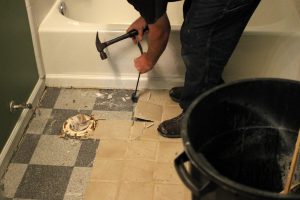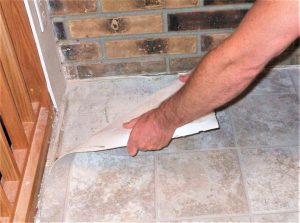
Floor removal is a task that needs to be done systematically with a lot of patience. If you don’t know how to do it, you must hire a trusted and experienced flooring removal Jacksonville company to get the job done. Here is a step by step guide for flooring removal for a Jacksonville, FL travel agency:
You can come across different types of flooring materials today. Many travel agency offices in Jacksonville are equipped with tile flooring. Tiles are the most popular choice available nowadays. There are also wooden floors and vinyl floors.
Tools you need for a flooring removal Jacksonville project
You can find different types of tools, including hand and power tools. Here is a list of tools that people often use:
– Pry bar
– Chisel
– Hammer
– Floor scraper with a long-handle
– Screwdriver
– Shovel
– Bucket or trashcan
– A broom or Shop Vac
Step by step guide for a tile flooring removal for a Jacksonville, FL travel agency
Step 1
Use the safety gear
Accomplished flooring removal Jacksonville professionals always make use of the right tools to get the job done efficiently. You need to follow their method of approach to make the task a lot easier. It is also equally important to use the right gear to ensure optimal safety. Proper safety gears always keep you safe while performing the tile removal tasks in a Jacksonville, FL travel agency.
Being extremely sharp: broken tiles can easily cause you an injury. It is always advisable to wear long-sleeved shirts and pants to stay protected. You should also wear gloves and safety goggles while removing tiles and cleaning the area. Further, a safety mask is a smart choice. Since tile removal generates high quantities of dust, wearing a mask helps you not to breathe in the dust.
Step 2
Prepare the area
You have to prepare the area before start removing tiles. In other words, you should get the office space ready to make the task easier. It is not a difficult task and requires only minimal time. Never undermine the importance of area preparation when you plan for the flooring removal Jacksonville project.
Take out all the free-standing items
All free-standing items and fixtures must be removed from the office space to a different location. When you get all objects out of the room, you are creating a convenient atmosphere for tile removal. Keeping some fixtures in the room, you are finding ways to hinder the smooth progress of work.
Get rid of baseboards on walls
You need to remove baseboards on your walls. It can be done with the help of a hammer and a pry bar. Some people use a screwdriver to take off the baseboards. Importantly, you have to do it with caution. Any damage does not allow you to reinstall them.
Don’t forget to seal the vents
Dust is always an issue when it comes to removing tile floors. Your air system may get clogged with debris and dust if you don’t cover the vents properly. You might have seen accomplished flooring removal Jacksonville experts covering the vents with painters’ tape or plastic wrap. If you are planning to remove tiles yourself, never start work before sealing the air system vents.
If you have a sink or toilet in your Jacksonville travel agency, don’t forget to turn off the water supply. To remove a toilet, you need to drain the reservoir and bolts. It can be a daunting task to move some items, especially, things like built-in shelving. You can cover or seal them to prevent dust exposure and damage.

Step 3
Choose an exposed bare edge or a place where a tile is damaged or non-existent to start with.
When it comes to removing floor tiles, you need to locate a starting point. How to find a start point for your flooring removal Jacksonville project? It is not a difficult task. Following the footsteps of professionals, you can easily find an area to start with. Look for a place where a tile does not exist. It can be a spot under the vanity or any another fixture. You can also search for a damaged, cracked, or loose tile.
How to find an edge? As mentioned above, it can be under a vanity or a threshold. The threshold needs to be popped off to discover the clean edge of a tile. It is always advisable to look for a clean edge so that you can peel it up fast and easy.
Many people may find it hard to locate these types of spots. What to do in such a situation? You need to create a starting point. Choosing a corner or doorway, experienced flooring removal Jacksonville, Florida professionals easily create a starting point. You can follow this method of approach. At corners and doorways, you can find spots where the tile does not continue to the next room.
If you cannot spot all these types of areas, you can make use of a chisel and hammer to break a tile to start your job. Based on the nature of underlayment and the way the tiles are affixed, the removal task becomes easy or complex. Sometimes, you may need to put in some extra efforts to remove the tile. A pole scraper or pry bar can also be used to make the removal easy.
If you manage to find a starting spot for your flooring removal Jacksonville project, you need to focus on some vital aspects before keep removing tiles:
– Make use of a hammer, chisel, or a pry bar to break out a few tiles.
– Take out the broken pieces and put them in a trash can or bucket.
– Pick up all large pieces to make your task easier as you progress. (Don’t bother about removing all small pieces)
– Check for underlayment damage after picking up a few tiles.
– You can utilize a pry bar to remove stubborn tiles.
Step 4
Continue to pull up tiles
So, you have already found a starting point and pulled a few tiles. Keep pulling up tiles from the starting point. After removing enough tiles, you can make use of an air hammer or a long-handled floor scraper with a chisel set to make the removal faster.
Getting underneath a tile is critical before pulling it away. You must be careful about the underlayment. Don’t worry about the breakage of old tiles. Some of them can be taken out fast with minimal effort. You may find it hard to remove some others.
Never allow the tiles to pile up as you keep removing one by one. It is always advisable to deposit them in a bucket or a trashcan to minimize clutter. Whenever the trashcan turns full, you must haul away to prevent unwanted waste accumulation. This approach makes your flooring removal Jacksonville project smooth and hassle-free.
Remember these things as you keep prying up tiles
– Never apply excessive force to remove tiles to prevent floor damage and personal injury.
– You can collect bigger tile chunks using a shovel to dump in a trashcan or bucket.
– Use only a hammer and a chisel while removing tiles near cabinets or walls to safeguard those surfaces.
This phase of your flooring removal Jacksonville project can be highly time-consuming. You should be persistent with your efforts. Don’t feel disheartened or frustrated if it takes longer than you expected.
Step 5
Access and check the underlayment
You can find a layer of underlayment underneath the tiles. It sits between the finished flooring and the subfloor. The most common material used to make underlayment is plywood. Many modern homes make use of a mortarboard or cement board instead of plywood. If your travel agency building is an older one, you may find the tiles being installed directly to a wood or concrete floor.
The main disadvantage of plywood is that it absorbs moisture and expands to cause tile cracks over time. Nevertheless, plywood is a smart underlayment choice for floors such as linoleum and vinyl. There is no need to remove plywood underlayment and subfloor panels if you find them in excellent condition. Damaged or expanded underlayment must be replaced with new ones immediately.
Step 6
Clean the surface
Cleaning the surface is an inevitable thing. Clearing the underlayment of all dust, debris, nails, adhesives, and other types of chunks, you are creating a perfect environment for new floor installation.
Make use of a shovel to scoop up the broken tiles, underlayment chunks, and adhesive and dump them in a trash can or bucket. When it comes to disposing of them, you can seek the help of your local disposal center. For a larger project, you can certainly choose a dumpster rental for responsible tile and debris removal.
Using a shop-vac, professional flooring removal Jacksonville companies vacuum up dust and debris. You should follow this method to clean the area efficiently. Cleaning is a very vital task. What makes it critically important? If dust stays on the subfloor or underlayment even after the cleaning, you cannot expect a new floor adhering to the surface genuinely. So, take time and clean the surface patiently.
Tips on removing adhesive
– Use a citrus-based adhesive remover to cover the adhesive patches. You can buy them from a home improvement store.
– Leave it there for a specified period as recommended by the manufacturer.
– Utilize a scraper for grinding out the loosened material. If the tile installation was done using tile mortar, a chisel and hammer need to be used to scrape away the larger adhesive pieces.
– Place these adhesive patches in a trashcan or bucket.
Step 7
Remove the underlayment
You can reuse the underlayment if it is not damaged. If you find this layer torn up after the adhesive removal or water-damaged, you need to remove it. After removing the exposed nails and screws, the underlayment should be lifted with the help of a pry bar. As you take off the underlayment, you need to be very careful about the nails to prevent any type of injury. Each flooring type comes with its own exclusive underlayment requirements. The cost and duration of the project vary according to the floor type you prefer.
Step 8
Examine the subfloor
If you remove the underlayment, you have to check the subfloor for divots, rotten wood, holes, and other types of damages. Examine the subfloor level and make sure that it is even, damage-free, clean, and smooth to make the new floor installation result-oriented. If there are any issues, you have to perform the necessary floor patching and maintenance works to make the surface clean and even.
How to remove wooden flooring?
Removing wooden floors is a lot easier compared to tile removal. The tools required for this task are:
– Pry bar
– Duct tape
– A pair of pliers and nippers
– Mallet or hammer
– Electric skill saw
Step by step instructions
1. Use protective gear
2. Clean the surface
3. Cut the boards using a skill saw. Always cut one board at a time. You should also focus on cutting smaller pieces
4. Make use of a hammer and a pull bar to remove the floor pieces.
5. Clean the debris and junk
Flooring removal for a Jacksonville, FL travel agency is not an easy task. For the uninitiated, it is going to be a time-consuming project. As you progress, you often would end up facing many challenges. Based on the flooring material, you need to choose the right tools and methodology. If you don’t have a clear idea about this type of project, it is always advisable to hire a professional company to get the job done. Using the right tools and modern technology, experienced flooring removal Jacksonville professionals get the job done responsibly.
Trained specialists have the experience and expertise to perform this task efficiently. You can save your valuable time and effort if you seek professional help. With the help of most sophisticated equipment and technology, seasoned flooring removal Jacksonville experts perform all tasks with improved efficiency and speed. You can find them using emission-free, battery-powered equipment with enhanced productivity. These types of machines can remove the entire flooring from a large travel agency office space within a few hours.






